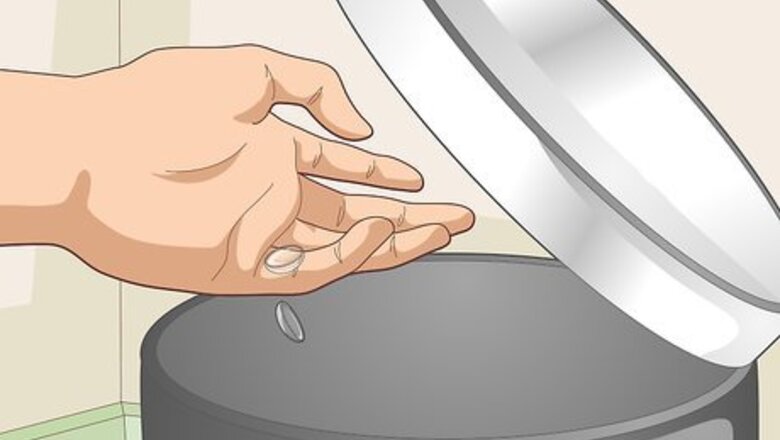
views
Using a Temporary Case Alternative

Throw out your contact lenses if at all possible. If you don't have your contact lens case (or worse, have neither a case nor solution) with you and you need to take out your contacts, the best thing you can do is throw away your contact lenses. While there are temporary alternatives you can try, they will not keep your lenses as clean as they should be, and could lead to infection. Keep a pair of eyeglasses with you just in case you need to take out your contacts and don't have a case or solution with you. Eyeglasses also come in handy if your contacts are irritating you and you need to take them out, but still need to see properly.Tip: If you have a hard time carrying a case and contact solution with you, talk to your eye care professional about daily lenses. These are designed for you to wear only once and immediately throw away, so you don't have to worry about storing or cleaning them.
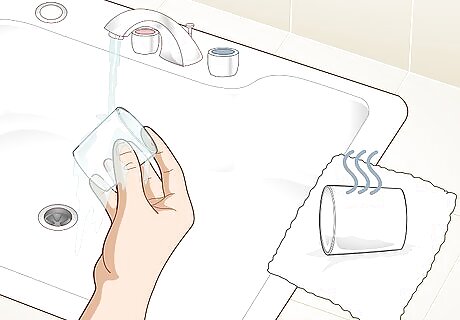
Wash and dry two drinking glasses. Before you put your contacts into anything, including a contact lens case, the surface should be clean. This doesn't require any special cleaners or chemicals, you can simply wash them thoroughly with warm soapy water. Smaller glasses are generally better than larger glasses because you'll have to be able to reach down inside them to get your lenses out. If you have access to a pair of shot glasses, those might be the best to use. You could also try short juice glasses. Pat the surface dry inside and out with a paper towel. Don't allow any water to get in contact with your contacts. Label the glasses "L" and "R" so you'll know which lens is which. You can write the letters on a piece of tape you stick to the glasses or write them on whatever you plan to use to cover them with. Just make sure the letters are large enough that you can read them without your contacts in.Warning: Avoid using disposable paper cups, as the paper may soak through, causing your lenses to dry out. Use plastic cups as a last resort.
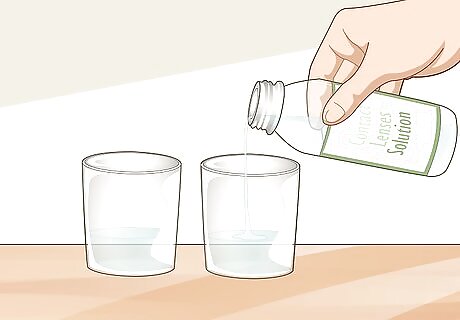
Put contact lens solution in the disinfected glasses. The contact lens solution recommended by your eye care professional is the best thing to soak your contacts in. If you happen to be without that as well, a basic saline solution, such as lens rewetting drops, will work. However, a basic saline solution will not disinfect your lenses the way a contact lens solution would. Never soak your contact lenses in water, even bottled or distilled water. It contains bacteria that can contaminate your lenses and cause eye infections. In addition to the risk of bacterial infection, some contact lenses are made from a hydrophilic material that absorbs water. These contacts will swell if soaked in water, making it impossible for you to put them back in your eyes comfortably. Even though this is a less-than-ideal alternative, it's still better than simply sleeping in your lenses. This causes your eyes to be deprived of oxygen and makes them more vulnerable to inflammation and infection.Warning: Don't attempt to make your own saline solution. It will still contain fine grains of salt that could damage your contacts.

Wash your hands before taking out your contacts. Use warm, soapy water to thoroughly clean your hands, then dry them off with a paper towel. Make sure your hands are completely dry before you touch your contact lenses. Even if your hands are clean, avoid touching your lenses with your nails, which may still contain bacteria.
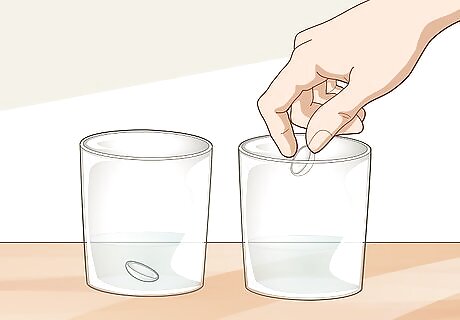
Drop your lenses into the solution. When you take out your lenses, immediately place them into the glasses with the solution you've prepared. Make sure you've put each lens into the correct glass to avoid cross-contamination. If you're using a taller glass, take care to make sure the lens doesn't get stuck to the side of the glass. After you drop in the lens, make sure it's completely submerged in solution. Add more solution if necessary until the lens is covered.
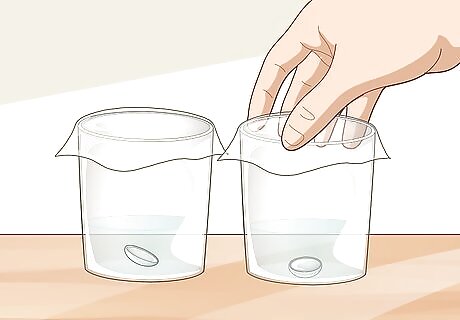
Cover the tops of the glasses with plastic or paper. Cover and seal the container you're keeping your contacts in as much as possible. Placing some sort of cover over the tops of the glasses keeps the contact lens solution from evaporating as well as keeping airborne bacteria from contaminating the solution and your contacts. If you're in a hotel room, there might be paper sanitation caps placed over the drinking glasses. You can use those as make-shift lids. You can also use any paper or plastic secured around the top of the glass with a hair tie or rubber band.
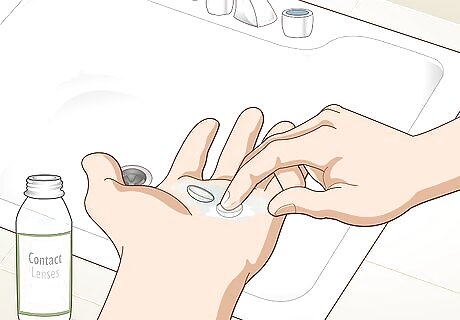
Clean your contacts before putting them back in your eyes. Your temporary storage solution doesn't keep your contacts as clean as they need to be and they're still vulnerable to bacteria. Use a hydrogen-peroxide based contact lens cleaner to thoroughly disinfect them, then rinse them off with a saline solution to neutralize the hydrogen peroxide before putting them back in your eyes. Even if you didn't have cleaner with you originally, you've hopefully had time to go get some in the meantime. You can get contact lens cleaners and solutions at any pharmacy. Convenience stores often have them too. Even though they might not have the brand you normally use, whatever you can find will work in a pinch.
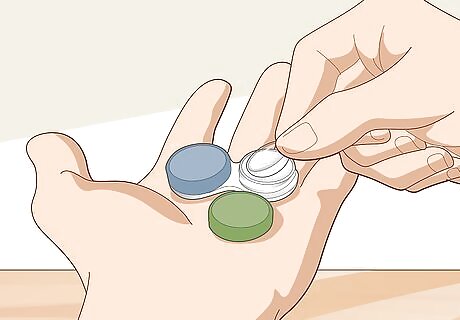
Buy a new case if you're going to be away longer than overnight. Don't use a DIY storage method for longer than one night. If you're traveling and forgot to bring your case with you, temporary storage buys you enough time to go out and get a proper case and solution to care for your contacts. You can buy contact lens cases at any pharmacy or discount store, or wherever health and beauty products are sold. Often, bottles of contact lens solution come with a free case.
Caring for Your Lenses
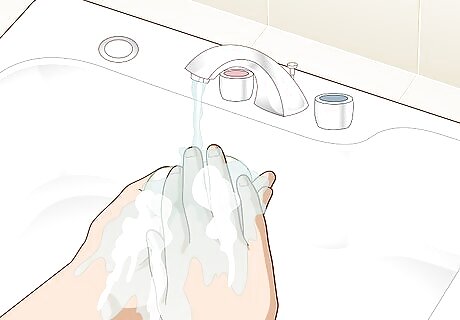
Wash your hands with soap and water before touching your lenses. If your hands aren't clean, you can introduce bacteria to your contact lenses or to your eyes. Wash your hands for at least 20 seconds, then dry them thoroughly with a paper towel. If you touch anything during the process of putting in or taking out your lenses, wash your hands again. For example, if you take out one lens and then scratch an itch on your arm, you need to wash your hands before taking out the other lens. Use a paper towel or lint-free cloth to prevent lint or fuzz from getting on your fingers and transferring to your lens.
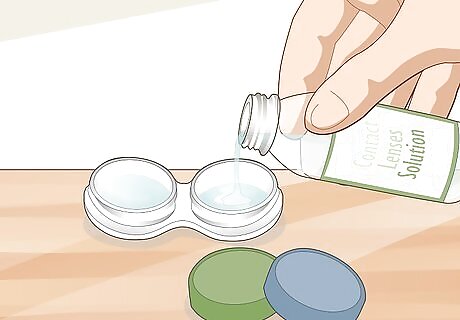
Use fresh solution every time you store your lenses. Only store your contacts in solution that is fresh and has been squirted directly from its original bottle into the case. Don't "top off" old solution with new solution. Don't transfer solution from one bottle to another, for example, into a smaller bottle for travel. Once the solution is exposed to the air, it is no longer sterile. Keep your contact lens solution bottle closed tightly, and never allow the tip of the bottle to touch any surface, including your fingers or hands. When you open a new bottle of contact lens solution, write the date on the bottle so you'll know when you broke the seal. Throw out the bottle one month after opening, even if there's still some solution left. One month after opening, the solution is no longer considered sterile.

Clean your case after every use. When you put your lenses in your eyes, pour the old solution out of the case. Squirt more solution into the case and swirl it around to clean the case. Then, store your case upside down on a paper towel so it can dry in between uses. Don't rinse your case out with tap water. The water has bacteria that could contaminate your case, especially if the case is made of plastic, as most contact lens cases are. At least once a week, clean your case with warm, soapy water. Rinse it thoroughly after washing it, then dry it with a paper towel.

Replace your contact case at least once every 3 months. Even with regular cleaning, your case may build up bacteria over time. While you should replace your case every 3 months at a minimum, it's generally easier to simply replace it every month when you replace your solution. If you notice any crust or build-up on your case or in the lid of your case, replace it immediately, even if you've only been using it for a couple of weeks.Tip: Most bottles of contact lens solution come with a free case. You may also be able to get free cases from your eye care professional.
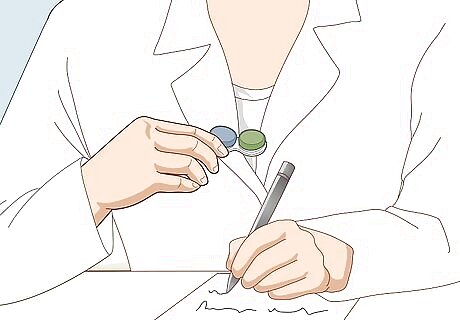
Follow your eye care professional's instructions regarding your lenses. Your eye care professional makes recommendations based on your eyes, your medical history, and the type of lenses you're wearing. Follow the schedule they give you for wearing and replacing your lenses. They will also explain to you how to clean and store your lenses when you're not wearing them. Different types of contact lenses require different types of contact lens solutions. If your eye care professional recommends a particular brand, follow their recommendation. If the brand they recommended seems expensive, ask if there is a lower-cost alternative you can use.















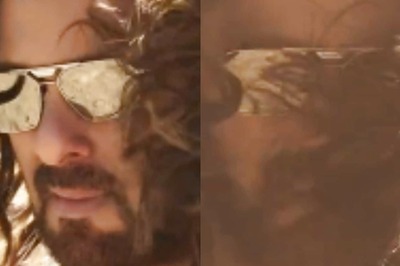


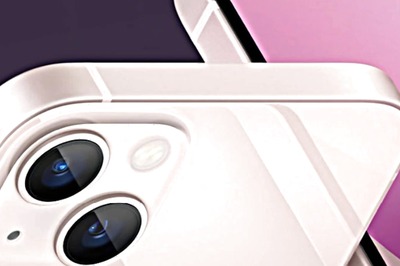

Comments
0 comment